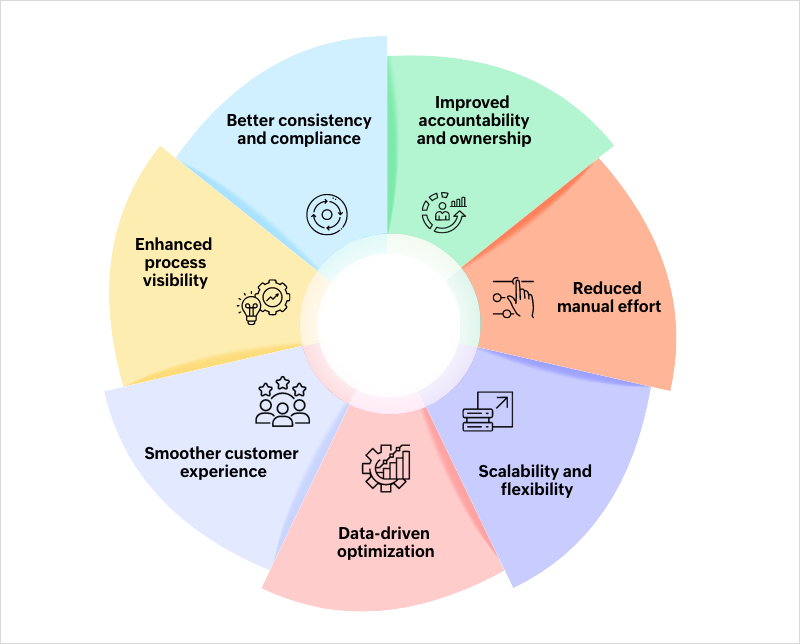- HOME
- Know Your Tech
- Why every growing business needs a workflow management system
Why every growing business needs a workflow management system
- Last Updated : May 5, 2025
- 57 Views
- 5 Min Read
Managing business operations involves more than just assigning tasks and tracking deadlines. As organizations expand, processes naturally grow more complex, involving multiple teams, departments, and approvals. Without a clear system in place, inefficiencies can easily build up, mistakes become more frequent, and projects take longer to complete.
Workflow management systems help businesses bring order to this complexity. By mapping out processes, automating routine steps, and ensuring accountability at every stage, they allow teams to operate with speed, accuracy, and transparency.
What is a workflow management system?
A workflow management system is software that defines, executes, and monitors a series of tasks within a business process. It ensures that tasks move through the correct sequence, reach the right people at the right time, and are completed under the right conditions.
Beyond tracking tasks, workflow management software often includes tools to model processes visually, automate routine steps, and integrate with existing systems. These systems include CRMs, ERPs, and HR platforms. In doing so, it becomes a crucial part of an organization’s broader business process management (BPM) strategy, making operations more efficient and adaptable. This kind of workflow automation software plays a key role in strengthening core business processes.
7 benefits of a workflow management system

Enhanced process visibility
A big frustration at many organizations is not knowing where requests stand. A workflow management system provides real-time status updates so everyone—from front-line employees to senior managers—can see exactly which tasks are pending, which are in progress, and which are complete.
This visibility is one of the most immediate workflow management benefits, helping businesses with their projects without unnecessary back and forth.
Better consistency and compliance
Standardizing processes ensures that each task is performed the same way every time, reducing errors and ensuring compliance. Workflow management software enforces these standards automatically. Since mandatory fields, required approvals, and audit trails are built in, the chance of something critical being skipped or overlooked is minimal.
Following a well-defined workflow management process also makes it easier for businesses to maintain and meet regulatory requirements.
Improved accountability and ownership
With clearly defined roles and the help of automated notifications, team members can always know what they need to do and when. Tasks are assigned rather than assumed, and the system logs who did what and when. This clarity not only speeds up collaboration but also fosters a culture of accountability: people start taking ownership of their tasks because there’s no ambiguity about responsibilities. A strong workflow process also ensures that no critical step is missed and ownership is clearly tracked across teams.
Reduced manual efforts
Manual hand-offs, email chains, and repetitive data entry eat up valuable time; but a workflow management system helps you automate these routine tasks. By eliminating manual tasks and reducing repetitive tasks, businesses can save hours that can later translate into significant cost reductions and productivity gains.
Scalability and flexibility
As your organization grows, so do your processes. A well-set workflow management system allows you to tweak existing workflows or build entirely new ones without starting from scratch. Whether you need to add a new approval layer or integrate with another system, the platform scales with you and adapts as your requirements evolve.
Data-driven optimization
Every action within a workflow management system is logged and time-stamped. By analyzing this data, you can uncover patterns like where tasks frequently stall, which steps take the longest, or which team members are overloaded. With the help of these insights, you can easily fine-tune your processes, allocate resources more effectively, and drive continuous improvement. Tracking these metrics is essential for businesses looking to continuously optimize workflow management.
Smoother customer experience
At the end of the day, streamlined internal processes lead to happier customers. Faster approvals, fewer errors, and clearer communication all add up to a quicker response time and higher-quality deliverables. Be it handling a support ticket or launching a new campaign, a workflow management system helps deliver consistently better service.
Efficient automated workflows also ensure that customer-facing activities run without unnecessary delays or confusion.
How low-code platforms can help strengthen workflow management
While a workflow management system already facilitates structure and efficiency, implementing it through a low-code platform like Zoho Creator can take those advantages even further.
With visual drag-and-drop builders, reusable templates, and easy integration tools, businesses can create, modify, and scale their workflows up to 10x faster than traditional development methods.
This ease of customization not only improves project delivery but also empowers non-technical teams (often called citizen developers) to contribute directly in building and improving the workflows they rely on.
Two organizations that built custom apps on Zoho Creator:
Let's look at two organizations that used Zoho Creator to build custom workflow applications—and the results they achieved:
Aboitiz Equity Ventures
Managing $8.1 billion in assets and coordinating over 200 CSR initiatives across diverse sectors, Aboitiz needed a scalable solution to manage project approvals and track performance across teams. Using the Zoho Creator low-code platform, they built a comprehensive CSR management app in just 60 days, integrating over 1,000 dynamic workflows and dashboards.
The results?
- 46 separate applications were launched without a line of code from IT.
- Over $670,000 is saved annually by eliminating manual paperwork and approvals.
- Executives have clearer visibility through project dashboards.
Melchers Malaysia
Part of the C. Melchers Group since 1958, Melchers Malaysia manages trading operations across multiple industries. Before Creator, they were facing significant challenges in paper-based credit applications and calibration tracking.
By adopting Zoho Creator:
- They digitized their calibration tracking system, reducing manual errors and ensuring consistent record-keeping.
- Compliance audits, once week-long exercises, became quick checklist-driven processes.
- Team productivity rose by 60% after eliminating manual paperwork and internal follow-ups.
Both organizations demonstrate how combining workflow management principles with flexible low-code platforms can transform operational efficiency, visibility, and collaboration.
Why it's worth getting your workflows in order
Investing in a workflow management system is about setting a foundation for sustainable growth.
By bringing transparency, accountability, and efficiency into everyday processes, businesses can reduce costs, deliver better, and respond more flexibly. And when combined with a low-code platform like Zoho Creator, the benefits multiply, giving even non-technical teams the power to adapt, automate, and innovate without barriers.
No matter the size or industry, the right workflow management system can ensure your teams are on track and not being slowed down by repetitive, manual processes.
 Ann Elizabeth Sam
Ann Elizabeth SamHey! I'm Ann, and I work as a content writer at Zoho Creator. I'm exploring the SaaS world through various forms of content creation. Outside of work, I love dancing and would give up anything to read a good murder mystery.





